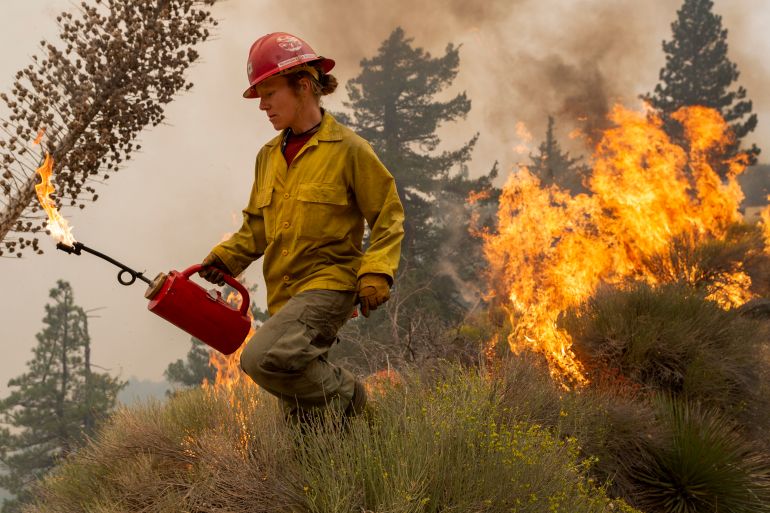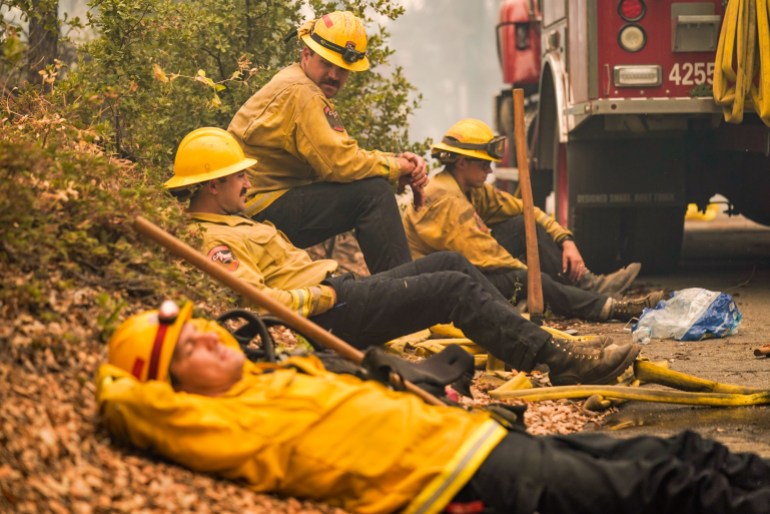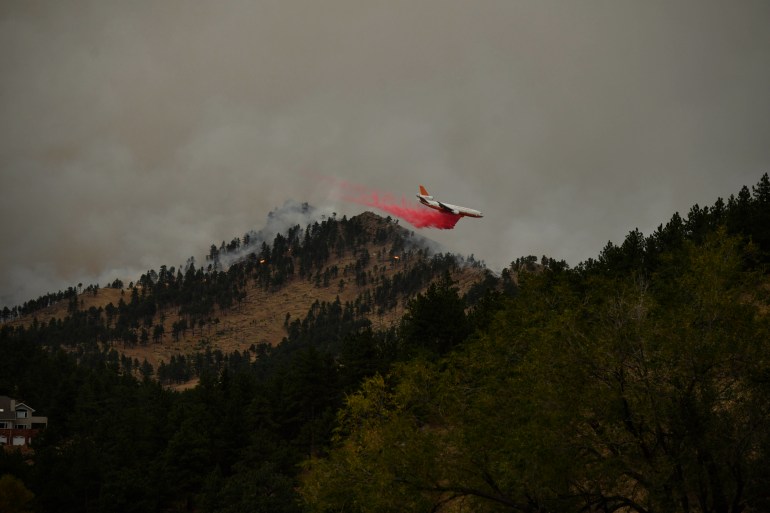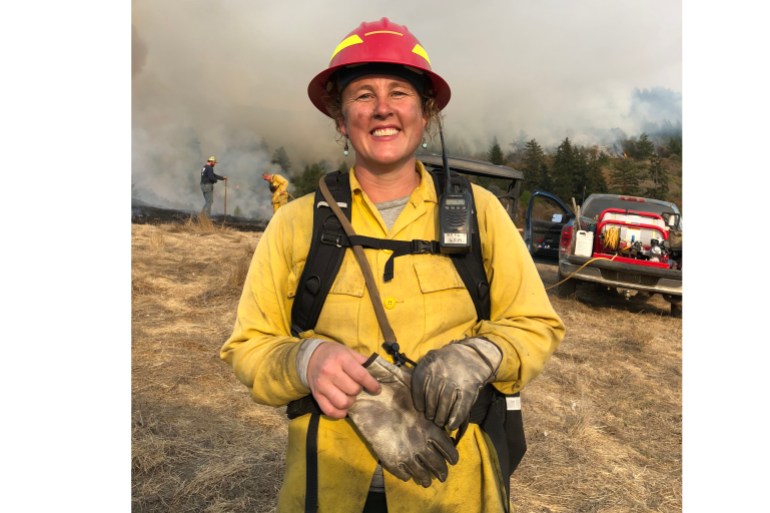Amid devastating US fires, experts urge fire prevention rethink
Calls grow for state and national prescribed burns strategies to prevent repeat of huge wildfires in Western states.

San Francisco, United States – It is the fuel – the dry grass, the crispy leaves, the parched shrubbery and the dead trees caused by climate change’s shortened rainy season – that is making the 2020 fire season one of the worst in US history.
Some 3.4 million hectares (8.3 million acres) were burned in Washington state, Oregon, California, Arizona, Colorado, Idaho, Nevada, and Wyoming by mid-October. In 2019, about half as much territory was burned in the western United States.
Keep reading
list of 4 itemsTurtles swimming to extinction in Malaysia as male hatchlings feel heat
Could shipping containers be the answer to Ghana’s housing crisis?
Thousands protest against over-tourism in Spain’s Canary Islands
The fires raging across the region were raised during the first US presidential debate between Donald Trump and the Democratic challenger Joe Biden last month.
“The forest floors are loaded up with trees, dead trees that are years old and they’re like tinder and leaves and everything else. You drop a cigarette in there the whole forest burns down. You’ve got to have forest management,” said Trump, when asked about the blazes.
The president previously alienated many in the fire community – firefighters, academics who study fire, and forestry management types – with a 2018 tweet about “proper forest management” during the deadly Camp Fire in California.
More than 62,000 hectares (153,000 acres) were burned in that blaze, 14,000 homes destroyed and 86 people were killed.
Although Trump has spoken and tweeted about forest or fuels management, his administration has not increased funding for it. Moreover, Trump’s scepticism towards climate change means his words have not been warmly received by those who work in the field.
“I am sick of [the issue] being politicised,” said Lenya Quinn Davidson, University of California Fire adviser, adding the scale of the fires showed the need to change policy towards fire management. “These wildfires have really brought attention to the need for prescribed burns.”

Prescribed burns
A prescribed (or controlled) burn is an operation where firefighters enter forests and set the fuel alight in a contained, controlled burn. The result is when fire season begins, the flames have less vegetation to feed on and are less powerful.
The practice of prescribed burns has a long history among Native American communities as a tool of fire prevention. Yurok Tribe Cultural Fire Management Council President Margo Robbins told Al Jazeera the tribe has adapted its use of fire since its inception.
“Yurok cultural lifeways are fire-dependent. Some of the plants we rely on for basket-weaving materials need fire in order to reproduce. Our traditional food sources, such as deer, salmon, acorns and berries benefit from fire.”
With the Gold Rush in the mid-1800s came settlers and the Federal Government, and the Yurok and other Native Americans in California were removed from their lands.
The settlers rejected the Indigenous practice of intentional tribal burns; California outlawed it in the 1850 Act for the Governance and Protection of Indians, which also allowed Native Americans to be enslaved.
Karuk Tribe Deputy Director of Eco-cultural Revitalization Bill Tripp, whose tribal lands border Robbins’s, said the fire suppression era intensified with the passing of the Federal Weeks act of 1911, which enabled purchased land to be turned into national forests under the jurisdiction of the Forest Service.
“The Forest Service took it upon themselves to kill native Americans for burning,” he told Al Jazeera, citing a 1918 letter from a rogue USFS Ranger.
It has never been official USFS policy to kill native Americans.

Increased political will?
Tim Ingalsbee, a former wildland USFS and NPS firefighter who now runs the FUSEE (Firefighters United for Safety, Ethics, and Ecology) think-tank, told Al Jazeera huge wildfires could be prevented if there were a more robust state and national prescribed burn strategy.
“There wouldn’t be the big catastrophic fires that burned small towns, it would not be the disaster we’re seeing today,” he said.
Robbins says the intensity of the fires this year has created the national political and bureaucratic will to do more prescribed burns in order to prevent wildfires.
“I think that we have turned a corner and the tide is changing in terms of people’s view of, of what needs to be done,” she said.
National Park Service (NPS) Communications officer Tina Boehle told Al Jazeera the NPS and the US Forest Service (USFS) have a solid fire suppression policy.
“The National Park Service fuels management programme, which includes prescribed fire, continues to be of vital importance mitigating the risk of severe wildland fire,” she said.
“We all use the National Cohesive Wildland Fire Management Strategy, which has three goals – restore and maintain landscapes, create fire-adapted communities and respond to wildfire.”
“That said, the National Cohesive Wildland Fire Management Strategy recognizes that differences exist among partners and stakeholders on varied missions, legislation, and values to be protected,” Boehle added.
US Department of Agriculture Communication Coordinator Larry Moore, who speaks for the USFS, told Al Jazeera the USFS budget is $4.45m for the fiscal year
“About 60-70 percent of the USDA Forest Service annual accomplishments for hazardous fuels reduction are accomplished by prescribed fire,” he said.
“We will work closely with state partners to determine management needs and stewardship priorities. We will use all the tools available to us, including prescribed fire, and unplanned ignited fire (like lightning) to mitigate the risk of catastrophic fire.”

Challenges
Like in many western states in the fire zone, the environmentalist movement and the conservation movement are influential in California politics.
In the Golden State, in order to do a prescribed burn, one must obtain a waiver from the Environmental Protection Agency so there is no violation of the Federal Clean Air Act, which dictates the amounts of pollutants that can be released into the air.
“There’s a lot of hurdles, and a lot of the fire community has given up,” said Inglesbee.
The fire community welcomed the recent drafting of the National Prescribed Fire Act by the Senate Energy and Natural Resources Committee, which would fund fire suppression for Federal, state and local agencies that are cash strapped because of this year’s brutal fire season.
But it remains doubtful if the bill will get to the Senate floor for a vote, with COVID-19 economic relief legislation and the Supreme Court Justice nomination taking up much of the Senate’s time.
For now, Ingalsbee said people living in wildfire zones need to change their approach: “We have to re-learn how to live with fire, as the Native Americans did for millennia.”